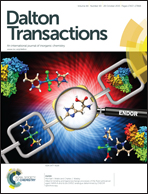Luminescent rhenium(i) tricarbonyl complexes with pyrazolylamidino ligands: photophysical, electrochemical, and computational studies†
Abstract
New pyrazolylamidino complexes fac-[ReCl(CO)3(NH![[double bond, length as m-dash]](https://www.rsc.org/images/entities/char_e001.gif) C(Me)pz*-κ2N,N)] (pz*H = pyrazole, pzH; 3,5-dimethylpyrazole, dmpzH; indazole, indzH) and fac-[ReBr(CO)3(NH
C(Me)pz*-κ2N,N)] (pz*H = pyrazole, pzH; 3,5-dimethylpyrazole, dmpzH; indazole, indzH) and fac-[ReBr(CO)3(NH![[double bond, length as m-dash]](https://www.rsc.org/images/entities/char_e001.gif) C(Ph)pz*-κ2N,N)] are synthesized via base-catalyzed coupling of the appropriate nitrile with pyrazole, or via metathesis by halide abstraction with AgBF4 from a bromido pyrazolylamidino complex and the subsequent addition of LiCl. In order to study both the influence of the substituents present at the pyrazolylamidino ligand, and that of the “sixth” ligand in the complex, photophysical, electrochemical, and computational studies have been carried out on this series and other complexes previously described by us, of the general formula fac-[ReL(CO)3(NH
C(Ph)pz*-κ2N,N)] are synthesized via base-catalyzed coupling of the appropriate nitrile with pyrazole, or via metathesis by halide abstraction with AgBF4 from a bromido pyrazolylamidino complex and the subsequent addition of LiCl. In order to study both the influence of the substituents present at the pyrazolylamidino ligand, and that of the “sixth” ligand in the complex, photophysical, electrochemical, and computational studies have been carried out on this series and other complexes previously described by us, of the general formula fac-[ReL(CO)3(NH![[double bond, length as m-dash]](https://www.rsc.org/images/entities/char_e001.gif) C(R′)pz*-κ2N,N)]n+ (L = Cl, Br; R′ = Me, Ph, n = 0; or L = NCMe, dmpzH, indzH, R′ = Me, n = 1). All complexes exhibit phosphorescent decays from a prevalently 3MLCT excited state with quantum yields (Φ) in the range between 0.007 and 0.039, and long lifetimes (τ ∼ 8–1900 ns). The electrochemical study reveals irreversible reduction for all complexes. The oxidation of the neutral complexes was found to be irreversible due to halido-dissociation, whereas the cationic species display a reversible process implying the ReI/ReII couple. Density functional and time-dependent density functional theory (TD-DFT) calculations provide a reasonable trend for the values of emission energies in line with the experimental photophysical data, supporting the 3MLCT based character of the emissions.
C(R′)pz*-κ2N,N)]n+ (L = Cl, Br; R′ = Me, Ph, n = 0; or L = NCMe, dmpzH, indzH, R′ = Me, n = 1). All complexes exhibit phosphorescent decays from a prevalently 3MLCT excited state with quantum yields (Φ) in the range between 0.007 and 0.039, and long lifetimes (τ ∼ 8–1900 ns). The electrochemical study reveals irreversible reduction for all complexes. The oxidation of the neutral complexes was found to be irreversible due to halido-dissociation, whereas the cationic species display a reversible process implying the ReI/ReII couple. Density functional and time-dependent density functional theory (TD-DFT) calculations provide a reasonable trend for the values of emission energies in line with the experimental photophysical data, supporting the 3MLCT based character of the emissions.


 Please wait while we load your content...
Please wait while we load your content...